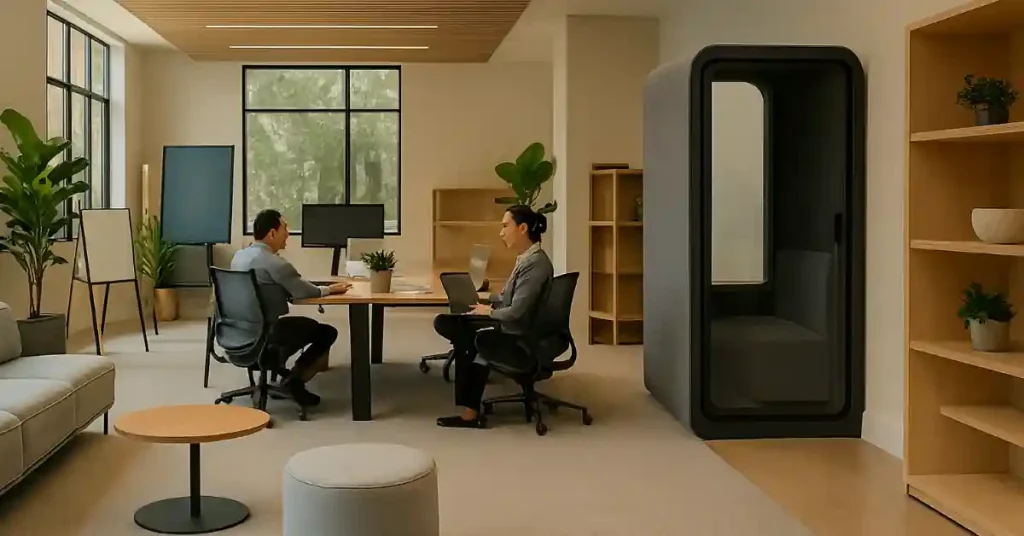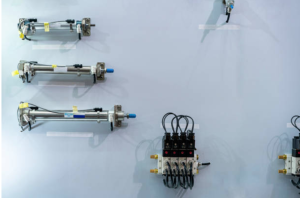In the hybrid working age, organisations across all sectors are reconsidering how their physical premises can facilitate productivity, flexibility, and employee well-being. While it is true that many companies have adjusted to this new working world with varying success, their offices are divided between those that make it work and those that genuinely enable hybrid teams.
So, what is the difference between great hybrid offices and average hybrid offices? It comes down to strong design principles, robust technology integration, and a solid understanding of people at work in contemporary buildings.
Human-Centred Design as the Foundation
Outstanding hybrid workplaces begin with one thing that average hybrid workplaces consciously neglect: human-centred design principles. The traditional cubicle workplace has evaporated in hybrid work cultures. Top-tier companies partner with a professional office interior designer in Delhi to design and deliver flexible spaces for diverse working styles.
This includes open collaborative spaces, idea rooms, employee lounges, meeting rooms, and a variety of quiet spaces to facilitate focus and collaboration depending on the workload. Natural light, acoustic design, ergonomic furniture, and calming aesthetics are not optional but essential in a design where employees occupy the office or home for flexibility and productivity. Creating pleasant workplaces is a design principle inspired by human-centred design; not obligatory, hybrid workplaces are these places teams want to return to, not have to return to.
Seamless Integration of Technology
Technology is not merely a support tool; it is the heart of an excellent hybrid office. The best hybrid offices do not view tech as an afterthought; they include it in the physical and digital environment from day one. Smart meeting rooms with syncing calendars and remote-friendly video conferencing tools, cloud-connected collaborative whiteboards, and occupancy sensors for optimal use of space work together and eliminate the divide between remote and on-site.
Simple things like reliable Wi-Fi coverage, wireless charging stations, or app-based desk bookings may seem trivial, but all improve the day-to-day experience of hybrid working. No friction, no delays and just a smooth, connected user experience, whether you are in the building or on the move.
Flexibility Is Built into the Space
Great hybrid offices are not fixed; they flex to the needs of the team. Rather than assigning designated workstations for everyone, progressive offices focus on modular layouts and multi-use zones. Movable barriers, height-adjustable desks, and flexible furniture that can be laid out in different ways allow space to be reshaped to changing demands, whether it is a brainstorming session with the team today and a solo deep work session the next day.
Some offices even have “neighbourhoods” or “activity-based zones” that allow staff to choose where and how they want to work depending on their mood or project. This autonomy enhances team morale and drives momentum towards productivity, especially with teammates bouncing back and forth from home to office.
Prioritising Employee Well-Being
What separates great hybrid offices from the rest is how intentionally they support well-being. Average hybrid offices may offer coffee machines and air conditioning, but exceptional ones go several steps further. They include wellness rooms for mental resets, biophilic elements like indoor plants and natural materials, and even dedicated spaces for physical activity like standing desks or compact gyms.
Hybrid work introduces the risk of burnout due to blurred boundaries. A thoughtfully designed space acts as a counterbalance by signalling structure and self-care. When employees feel mentally and physically supported, they naturally perform better, no matter where they’re logging in from.
A Culture of Belonging and Collaboration
Design and tech are vital, but great hybrid offices also foster a strong sense of community. Isolation is a real risk in hybrid models. That’s why leading companies use their physical spaces to reinforce team culture and inclusion. Shared cafes, project walls, and informal breakout zones create organic opportunities for interaction and collaboration.
They also invest in rituals and rhythms, team lunches, learning corners, open brainstorming days, that give employees a reason to come in beyond obligation. This emotional connection to the workplace builds loyalty and keeps hybrid models from becoming fragmented.
Thoughtful Zoning for Privacy and Focus
Great hybrid offices know when to turn the volume down. One major complaint in shared offices is the lack of concentration zones. Unlike average setups, high-performing workspaces provide intentional quiet areas where employees can block out distractions.
Think soundproof pods, solo booths, or deep-focus corners tucked away from communal traffic. These areas are critical for roles that require concentration, and they also respect the individual preferences of team members, some of whom may find the return to in-person work mentally draining without proper space to retreat.
Strategic Collaboration with Experts
Companies that stand out in the hybrid era often work with professional office interior designers who specialise in workspace strategy. These experts go beyond choosing colour schemes; they analyse workflows, employee behaviours, and company goals to create hybrid offices that genuinely function as a second home for hybrid teams.
From acoustic balancing to air quality, material choice to layout flow, every detail matters. And when done right, the ROI isn’t just in aesthetics but in improved productivity, talent retention, and workplace satisfaction.
Designing for the Future of Work
The shift to hybrid work isn’t a temporary adjustment; it’s a long-term evolution in how people engage with their jobs. Offices that excel in this new paradigm are more than just workstations and walls. They’re living, responsive environments built on empathy, adaptability, and intentional design.
Average offices may get by with basic setups and occasional tech upgrades. But the great ones? They think holistically. They plan with purpose. And most importantly, they understand that the hybrid offices are no longer just a place to work; it’s a place that should work for you.




